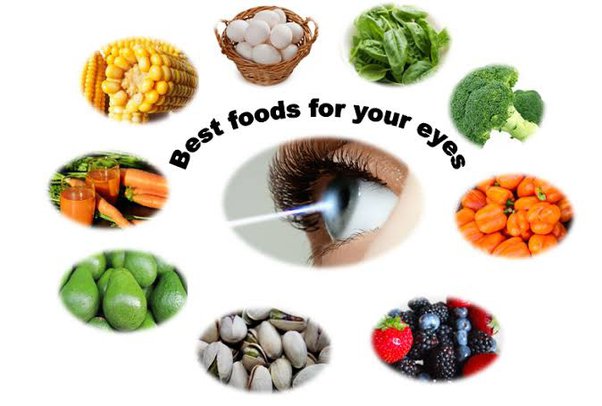
A balanced, healthy diet is essential to maintaining the health of your eyes and may lower your chance of acquiring eye disorders. If you eat foods that include a variety of vitamins, nutrients, and minerals, referred to as antioxidants, you may be able to prevent serious eye diseases. The first thing that comes to mind when we consider foods that enhance vision is a carrot. These typically orange root vegetables are high in rhodopsin, beta carotene, and vitamin A, all of which are good for the eyes and necessary for both night and color vision. These components may also shield the eyes against age-related issues including cataracts and macular degeneration, which are two of the main causes of vision loss and macular degeneration, respectively.
Red Peppers, raw
The foods highest in vitamin C per calorie are bell peppers. That’s excellent for your eye’s blood vessels and may reduce your risk of developing cataracts, according to scientific research. It can be found in a wide variety of fruits and vegetables, such as strawberries, bok choy, cauliflower, and papayas. Since heat degrades vitamin C, opt for raw foods whenever possible. Peppers with vibrant colors also contain vitamins A and E which are good for the eyes.
Sunflower Nuts and Seeds
Half of the daily vitamin E allowance for adults is found in an ounce of these seeds or almonds. Vitamin E, along with other nutrients, has been shown in a sizable study to decrease the progression of age-related macular degeneration (AMD). It might also aid in cataract avoidance. Other excellent sources of vitamin E include hazelnuts, peanuts (which are technically legumes), and peanut butter.
Dark-colored leaves
For instance, foods high in both vitamin C and vitamin E include kale, spinach, and collard greens. Zeaxanthin and lutein, two carotenoids, are also present. These plant-based vitamin A supplements reduce the risk of chronic eye conditions including AMD and cataracts. Western diets typically don’t include enough of these for most individuals.
Salmon
DHA and EPA are the two forms of omega-3 fatty acids your retinas require to function properly. Both are present in seafood in addition to fatty fish like salmon, tuna, and trout. Additionally, omega-3s appear to shield your eyes from glaucoma and AMD. Dry eyes have been associated with low levels of these fatty acids.
Sweet Potatoes
Sweet potatoes, carrots, cantaloupe, mangos, and apricots are among the orange-colored fruits and vegetables that are rich in beta-carotene, a type of vitamin A that supports night vision, or the capacity of your eyes to adjust to the darkness. Sweet potato also contains a small amount of vitamin E and more than half the daily recommended amount of vitamin C.
Lean Poultry and Meat
Zinc transports vitamin A from the liver to the retina, where melanin, a protective pigment, is produced. The highest amount of zinc per serving is found in oysters, but you don’t have to adore shellfish to get enough of it: Good sources include dark and white meat from chicken, hog, and beef.
Legumes and Beans
Want to slow AMD and maintain your nighttime vision sharpness by choosing a vegetarian, low-fat, high-fiber option? Black-eyed peas, kidney beans, lentils, and chickpeas are also rich in zinc. Additionally, a can of baked beans will work.
Eggs
A fantastic package offers Your body can better utilize the lutein and zeaxanthin from an egg’s yolk thanks to the zinc in it. These substances’ yellow-orange hue prevents damaging blue light from harming your retina. They assist in increasing the quantity of antioxidant pigment in the macula, the area of the eye that regulates central vision.
Squash
Lutein and zeaxanthin are not produced by the body, but they are available year-round in squash. Moreover, summer squash contains zinc and vitamin C. The winter variety also contains omega-3 fatty acids and vitamins A and C.
Brussels sprouts and broccoli
These closely related vegetables contain vitamin A (as lutein, zeaxanthin, and beta-carotene), vitamin C, and vitamin E, which is another potent combination of minerals. All of them act as antioxidants to shield the cells in your eyes from free radicals, an unstable molecular type that damages sound tissue. Your retinas are particularly weak.
Whole grains
It turns out that whole grains have several health benefits for the eyes in addition to being beneficial for your weight since they contain vitamin E, niacin, and zinc. They lessen the chance of blood sugar surges that can eventually harm the retina in addition to lowering the risk of cataracts and age-related macular degeneration. Whole grains contain zinc, which shields eye tissue from light and inflammation7.
Nuts
Among the many nuts that are beneficial for the eyes are almonds, peanuts, pistachios, and cashews. Omega-3 fatty acids and vitamin E, which are abundant in nuts, improve eye health and shield eye cells from “free radicals” that may damage the eye’s tissue.
